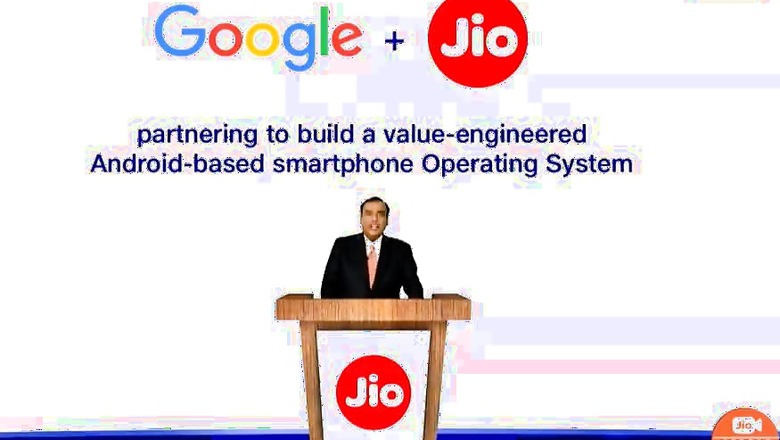
views
Earlier this week, Caesar Sengupta, Vice President of product, payments and The Next Billion venture at Google, said at the Google For India 2020 conference that the technology giant will help develop a “high quality, low cost” smartphone that will squarely target the millions of feature phone users in India. Following this up, Mukesh Ambani, chairman and managing director of Reliance Industries Limited, welcomed Google as an investor and strategic partner for Jio Platforms at the RIL AGM 2020 keynote yesterday.
The foremost partnership between the two companies will lead to the development of exactly what Sengupta spoke about earlier, with Ambani affirming that Google and Jio Platforms will collaboratively develop a custom operating system that will power smartphones squarely targeting the next billion users.
The move has lent strong credibility to Google’s promise, and suggests that the range of to-be-unveiled affordable smartphones can be a disruptive product in a market that has seen the appeal of sub-Rs 5,000 smartphones fade away in India due to a lack in returns. Key to this promise is the announcement of Jio 5G – India’s first and fully made-in-India 5G network infrastructure that simultaneously removes the need for India to source 5G technology from foreign players such as China’s Huawei.
Not only will the said smartphones be affordable, said Ambani, but will also be ready to make the most of 5G connectivity to offer real-life, appealing use cases for users that are still part of the feature phone demographic in India.
To understand the possible impact of this move, it is important to note how India’s mobile telephony industry is shaped right now. A highly attractive market for smartphone manufacturers by virtue of a unique demand for value-driven products, India has roughly 400 million smartphone users, while feature phone users outnumber them by a slim margin, according to IDC data. The 450 million-odd feature phone users are those for whom smartphones are so far a liability, and surplus to their requirements.
Feature phones, for instance, offer super-long battery life and reliable sturdiness. Additionally, smartphones so far have failed to offer appealing-enough use cases for these users, as a result of which, despite there being a massive segment of people in the country who are yet to jump on to the smartphone and data connectivity bandwagon, the adoption of smartphones have seen a slowdown in recent times.
It is this that Jio and Google’s partnership will address. With 5G connectivity, sectors like agriculture, education and healthcare will receive major boosts in terms of using technology to their benefits. Agriculture, for instance, can use 5G connectivity to get real-time weather updates, prediction on natural disasters, analysis of crop growth and more, all of which can significantly contribute to a healthier rate of produce for farmers.
In education, the Covid-19 pandemic has already underlined the need for remote education technologies. With the advent of 5G, it will become even more feasible to reach out to fringe areas and impart education to students. Even teachers can receive development training through remote platforms, and in comparison to what they could have achieved physically, will be able to address far larger groups of students in sessions. Students themselves will get access to real-time, immersive learning media, which can enhance their interests in topics.
Healthcare, similarly, can receive a strong boost in non-metropolitan areas with remote doctor consultations, and remote surgical procedures that a doctor can undertake. At the centre of all this are smartphones.
With strong use cases at hand, it is Jio and Google’s promise of a low cost device that can beckon the feature phone users to finally upgrade. The benefits of availing a smartphone will become evident, which in turn can lead to a steep rise in the adoption of smartphones in markets where feature phones still rule the roost. The co-developed, specially adapted operating system will also enhance the overall user experience and interface, far better than what Google could achieve with its Android Go venture.
India presently stands at the cusp of a new digital revolution, one which can bring the next billion users online with the promise of valuable services at nominal expense. Coupled with products such as JioMart for offering small business a digital business platform, and JioMeet to facilitate remote consulting, education and healthcare, the Jio-Google partnership is an exciting one – something that can truly transform the Indian technology as we know it today.




















Comments
0 comment